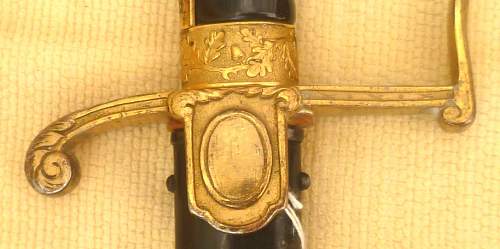-
08-31-2014, 09:29 AM
#261
-
08-31-2014 09:29 AM
# ADS
Circuit advertisement

-
08-31-2014, 09:58 AM
#262
-
09-02-2014, 10:55 AM
#263
-
09-02-2014, 11:40 AM
#264
-
09-02-2014, 11:55 AM
#265
-
09-02-2014, 01:52 PM
#266
-
09-12-2014, 12:21 PM
#267
-
10-01-2014, 10:18 PM
#268

Hi Kris, It is a fine looking sword and one which I would be happy to own!!!!! The blade!! Ah well, I'd rather have it with a cut blade than not have it at all. I like it and would be very happy to purchase it!!!!!!!
Nice one!! Regards Michael R
-
10-02-2014, 04:28 AM
#269

Hey Michael, glad you like it.
Sorry to say; but it is a other one I am meaning to keep. ...
I just had the same reaction as you when seeing it...
cheers
|<ris
-
01-24-2015, 07:56 PM
#270


by
Michael Ryan

Hi Fred, I absolutely agree with all you have said. However I must try and correct one minor error which I beleive you have made. I would suggest that the P guard swords are the evelutions of the P1796 British cavalry sabre and that the Prussian M1811 Bluchersabel is such an evelution?? Our French friends were very upset with us Brits as they considdered the 1796 as an inhu
man weapon because of the scale of wounds the blade inflicted on their troops. I have a rather poor 1796 and even as a very obsolete weapon over 200years old, I would not like to be on the receiving end of that fearsome blade!! Post some of your photos and if they are as bad as you say, we can have a laugh as well as an insight into your collection!!
Cheers once again Michael R
Hello Michael, You were correct (post # 127),  and I finally found a German reference that stated that thousands of the British M 1796 sabers were supplied to Prussia, with the sword being given formal - informal (uncertain) designation of the Prussian cavalry saber M 1808. Best Regards, Fred
and I finally found a German reference that stated that thousands of the British M 1796 sabers were supplied to Prussia, with the sword being given formal - informal (uncertain) designation of the Prussian cavalry saber M 1808. Best Regards, Fred






 .
.



































 and I finally found a German reference that stated that thousands of the British M 1796 sabers were supplied to Prussia, with the sword being given formal - informal (uncertain) designation of the Prussian cavalry saber M 1808. Best Regards, Fred
and I finally found a German reference that stated that thousands of the British M 1796 sabers were supplied to Prussia, with the sword being given formal - informal (uncertain) designation of the Prussian cavalry saber M 1808. Best Regards, Fred


Bookmarks